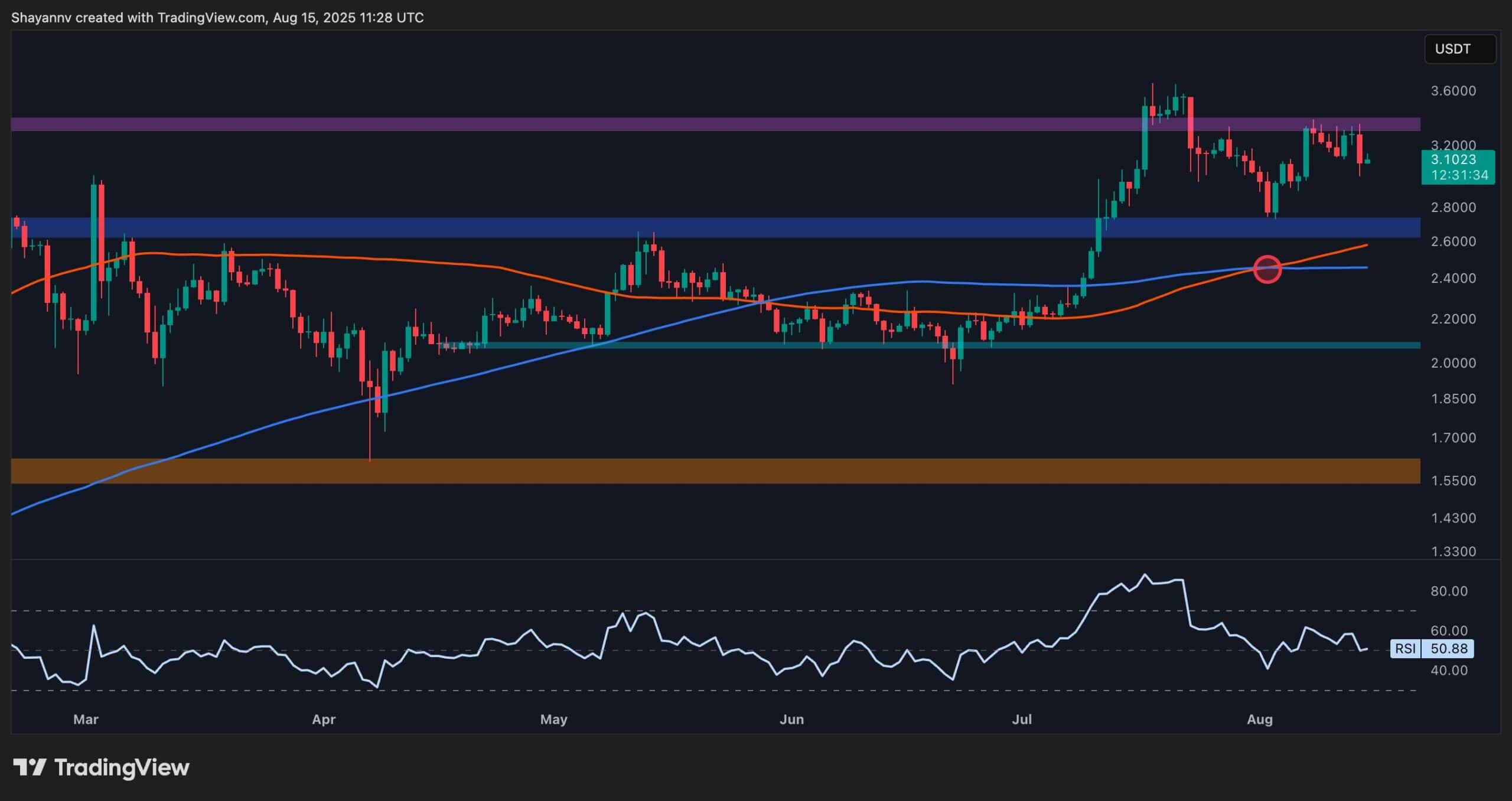Cryptocurrency
Redefining Money: America’s digital currency dilemma

On Wednesday, Sept. 20, the United States House Financial Services Committee marked up two bills to curb the issuance of a central bank digital currency (CBDC). One of the bills would stop the Federal Reserve from running any test programs on CBDCs without congressional approval, while the other would stop federal banks from using CBDCs for some services and products.
The principal political adversaries to a digital dollar are heavyweights such as Robert F. Kennedy Jr. and Florida governor Ron DeSantis, who have thrown their hats into the ring to become president a year from November.
In July, DeSantis said that CBDCs would never happen under his administration, citing concerns over consumers losing power over their own money. Kennedy, on the other hand, a known proponent of Bitcoin, is rallying against the digital dollar as it will “vastly magnify the government’s power to suffocate dissent by cutting off access to funds with a keystroke.“
No CBDC in Florida https://t.co/p9pwSTmrlN
— Ron DeSantis (@GovRonDeSantis) March 20, 2023
In May, Cointelegraph reported that according to its own research, more than 130 countries were at some stage of research into a CBDC, and only eight had rejected the idea outright. These countries are diverse, from France and Switzerland to Haiti and Bhutan. So, the question must be asked: Why would a country like the United States be so opposed to having its own digital currency?
The idea of a CBDC in itself is nothing too taxing. In essence, digital dollars would be based on blockchain technology rather than having traditional dollars moving around between accounts. That would dramatically decrease transfer times, cut fees, and do away with the “middlemen” — the intermediaries along the way who slow things down and take a cut for themselves.
The Federal Deposit Insurance Corporation found that in 2021, there were still 5.9 million “unbanked’ households in the United States, a massive number by any standard.
A CBDC would mean that the Federal Reserve would effectively oversee all the bank transfers in the country, as there would be no alternative. And having everything under one roof means one mistake or failure would affect everyone rather than be limited to one bank, for instance.
Recent: Indian state governments spur blockchain adoption in public administration
But perhaps the biggest argument against a CBDC is that, for cryptocurrency purists, having a central institution overseeing a currency is the very thing crypto was designed to avoid. Why now make a U-turn?
Political motivations play a significant role in the discussion in the United States. In March 2022, President Joseph Biden said his administration would “place the highest urgency on research and development efforts into the potential design and deployment options of a United States CBDC.”
This provided fodder for the Republican party to come out against the plan, citing invasion of privacy and claiming it was another form of government control. DeSantis even came out with an Orwellian prediction of the government stopping its citizens from buying fossil fuels or guns if such legislation were in place.
This is not to say that the U.S. hasn’t looked into a CBDC, as it has extensively.
In 2020, the Federal Reserve launched Project Hamilton to study the viability of a CBDC. By 2022, it had developed a system that took elements from the workings of Bitcoin but moved away from its rigid blockchain backbone. The result was a system that can process 1.7 million transactions per second, light years ahead of the Bitcoin blockchain and quicker even than Visa, which can deal with about 65,000 transactions per second.
David Millar, data center coordinator at Santander, told Cointelegraph: “The leaps forward they made during Project Hamilton were truly staggering. When we heard of the progress they were making, we believed that our entire infrastructure would need to be completely revamped within the next five years.”
Nevertheless, the project completed its initial phase in December 2022 and went no further. Once again, voices of dissent from Congress attacked the project, saying it had been carried out solely with academics and the public sector in mind and the average citizen would not benefit. Millar added:
“The time and effort that went into Hamilton and the results they produced; it’s a tragedy that most of it will never see the light of day.”
The issue of privacy is one of the most prominent foes of the digital dollar. The main argument of the dissenters is that if there is to be a digital dollar, it should effectively be like the cash dollar is now, with its benefits of anonymity coupled with the power and speed of a cryptocurrency. Those who favor a digital dollar argue that we already have such a thing, but it’s just not called that yet. Credit card money is digital for all intents and purposes, and are any of us mailing cash to Amazon to pay for things?
The world is moving toward a cashless society, and the U.S. is no exception. In 2022, only 18% of all U.S. payments were made in cash, down from 31% in 2016.
Magazine: ‘AI has killed the industry’: EasyTranslate boss on adapting to change
The U.S. is also a country of strange contradictions. While it surges ahead in many areas, such as technology, its banking system remains rooted in the traditional, with check payments still being the norm. Dragging a whole nation away from that is a tall order.
So, what does the future hold for a potential U.S. CBDC? Well, very little. Project Hamilton closed with no indication of a second phase, and according to Darrell Duffie, a professor of finance at Stanford’s Graduate School of Business, while work is continuing, it has slowed to a snail’s pace, and “nobody is charging ahead openly.”
It seems for the foreseeable future, this will be one part of the cryptosphere where the U.S. is not a pioneer.
Cryptocurrency
Ethereum Foundation, Whales, and Hackers: What’s Driving the ETH Sell-Off?

TL;DR
- Whales, hackers, and the Ethereum Foundation wallets moved over $500M in ETH through large sales and withdrawals.
- Ethereum transfers rose to 4.6M ETH, nearing the monthly high of 5.2M recorded in July.
- Staking inflows hit 247,900 ETH, the highest in a month, locking more supply from trading.
Large Withdrawals and Whale Activity
Ethereum (ETH) has seen heavy movement from major wallets over the past few days. On-chain data from Lookonchain shows a newly created wallet pulled 17,591 ETH, worth $81.62 million, from Kraken in just two hours.
Over three days, two new wallets withdrew a combined 71,025 ETH, valued at $330 million, from the exchange.
One of these wallets, address 0x2A92, has withdrawn 53,434 ETH, worth $242.34 million, in two days. This includes a recent purchase of 30,069 ETH, valued at $138.46 million, during a market drop.
Major ETH Holders Offload Millions Amid Price Rally
In contrast, several separate entities have been disposing of some ETH holdings. A wallet tied to a hacker address 0x17E0 sold 4,958 ETH for $22.13 million at $4,463, securing a profit of $9.75 million. Earlier this year, the same address sold 12,282 ETH at $1,932 and later bought back part of the amount at higher prices.
A different whale sold 20,600 ETH for $96.55 million over the past two days, generating a profit of more than $26 million after holding the position for nine months.
Meanwhile, an Ethereum Foundation-linked wallet, 0xF39d, sold 6,194 ETH worth $28.36 million in the last three days at an average price of $4,578.
Recent sales from the same wallet included an additional 1,100 ETH and 1,695 ETH for over $12.7 million combined.
The #EthereumFoundation-linked wallet(0xF39d) sold another 1,300 $ETH($5.87M) at $4,518 ~11 hours ago.
Over the past 3 days, this wallet has sold a total of 6,194 $ETH($28.36M) at an average price of $4,578.https://t.co/4hfCWymHVG pic.twitter.com/ErUyEY8SJy
— Lookonchain (@lookonchain) August 15, 2025
Network Activity on the Rise
CryptoQuant data shows Ethereum’s total tokens transferred have been climbing since August 9. After ranging between 1 million and 3 million ETH through late July and early August, transfers have risen to 4.6 million ETH, approaching the monthly high of 5.2 million recorded in mid-July. This increase has occurred alongside a price rally from about $3,400 to $4,600.
Interestingly, staking inflows generally stayed between 20,000 and 80,000 ETH per day over the past month. On August 14, inflows jumped to 247,900 ETH, the highest in the period.
At the time, ETH was trading near $4,600. Large staking deposits reduce the amount of ETH available for immediate trading, as staked coins are locked for a set period.
In the meantime, ETH trades at $4,647 with a 24-hour volume of $68.25 billion, down 2% on the day but up 19% over the week.
Binance Free $600 (CryptoPotato Exclusive): Use this link to register a new account and receive $600 exclusive welcome offer on Binance (full details).
LIMITED OFFER for CryptoPotato readers at Bybit: Use this link to register and open a $500 FREE position on any coin!
Cryptocurrency
Massive DOGE Whale Activity Hints at $1 Breakout

TL;DR
- Whales bought two billion DOGE this week, lifting their combined holdings to 27.6 billion coins.
- A single 900M DOGE transfer worth $208M to Binance drew attention to large exchange movements.
- DOGE broke key resistance, with momentum building for a possible push toward the $1 price mark.
Price and Market Moves
Dogecoin (DOGE) traded at $0.23 at press time, slipping 4% over the past day but still showing a 2% gain for the week. Daily turnover came in at about $6.18 billion.
Meanwhile, the broader crypto market saw over $1 billion in liquidations. Hotter-than-expected US Producer Price Index data pushed traders to scale back expectations of a near-term Federal Reserve rate cut. DOGE had roughly 290,500 coins liquidated during the sell-off.
On the two-week chart, analyst Trader Tardigrade notes that DOGE has cleared a downward-sloping resistance line after completing what appears to be a “wave V” in an Elliott Wave sequence. Similar setups in the past, where prolonged declines stayed within falling channels before breaking higher, have been followed by sharp rallies.
$Doge/2-week#Dogecoin is gaining strong momentum to surge above $1 pic.twitter.com/TuSEKr19nv
— Trader Tardigrade (@TATrader_Alan) August 15, 2025
Momentum gauges are also turning up. The Stochastic RSI, which had dropped into oversold territory, is now heading higher. Previous reversals from this zone have coincided with sustained upward moves. The current formation points to a possible run that could carry DOGE past the $1 mark.
Heavy Whale Buying and Large Transfers
As reported by CryptoPotato, blockchain data shows large investors have added two billion DOGE in the past week, spending just under $500 million. That brings their holdings to about 27.6 billion coins, or 18% of the supply. The buying streak has prompted speculation within the community.
Recently, Whale Alert flagged a 900 million DOGE transfer worth about $208 million into Binance. The tracking indicates that it originated from a wallet connected to the exchange, likely as an internal activity. The address involved holds 2.88 billion DOGE, one of the largest balances on the network.
Ali Martinez also reports that transactions above $1 million reached a one-month high, with activity building since early August and peaking as DOGE traded at $0.25.
Whales are back! Dogecoin $DOGE activity at a 1-month high. pic.twitter.com/C83Pv68mCt
— Ali (@ali_charts) August 14, 2025
Sentiment Building
Analyst Gordon described the current setup as “a nice bit of consolidation” before a potential breakout, adding,
“This will be one of the first coins normies FLOCK to & the pump will be MASSIVE.”
With whale accumulation rising, high-value transfers increasing, and a bullish technical pattern in play, DOGE is positioned for a potential push toward $1 if momentum holds.
Binance Free $600 (CryptoPotato Exclusive): Use this link to register a new account and receive $600 exclusive welcome offer on Binance (full details).
LIMITED OFFER for CryptoPotato readers at Bybit: Use this link to register and open a $500 FREE position on any coin!
Cryptocurrency
Ripple Price Analysis: XRP at Risk as Key Support Levels Could Trigger Sharp Drop

XRP has recently entered a consolidation phase after a strong rally earlier this summer, with the price action now hovering around key resistance levels on both its USDT and BTC pairs. Yet, while momentum has slowed, the charts still indicate a generally bullish structure, with multiple key support levels remaining firmly in place.
Technical Analysis
By ShayanMarkets
The USDT Pair
On the XRP/USDT daily chart, the price is currently trading near the $3.10 mark, facing a strong resistance zone around $3.40. This follows a breakout above the $2.70 range in July, which has now flipped into a support area.
Both the 100-day and 200-day moving averages are also trending upward and recently formed a bullish crossover around $2.45, reinforcing the medium-term bullish sentiment. If the $3.40 resistance breaks, a push toward the critical $4.00 range becomes likely.
However, the RSI hovering near the neutral 50 level suggests a lack of strong momentum for now, meaning a short-term pullback into the $2.80 support zone is still possible.
This zone will be key for maintaining the bullish structure. Losing it could open the door for a deeper correction toward the 200-day moving average located around the $2.40 mark. Yet, as long as the price stays above the moving averages, the broader trend remains bullish.
The BTC Pair
Looking at the XRP/BTC chart, the pair has recently pulled back after hitting the 3,000 SAT resistance, with the price currently around 2,600 SAT.
This follows a clean breakout above the long-term descending channel and a successful retest of its upper boundary, which coincided with the 200-day moving average and the 2,400 SAT support zone. This confluence remains a key bullish technical factor, as holding above it could attract renewed buying pressure.
That said, RSI levels around 48 show that momentum has cooled after the sharp July rally, meaning XRP may continue ranging between 2,400 SAT and 3,000 SAT in the near term. A decisive close above 3,000 SAT would likely open the path to the 3,400 SAT zone, while losing 2,400 SAT could shift the bias back toward 2,000 SAT support. For now, the structure still favors the bulls as long as higher lows remain intact.
Binance Free $600 (CryptoPotato Exclusive): Use this link to register a new account and receive $600 exclusive welcome offer on Binance (full details).
LIMITED OFFER for CryptoPotato readers at Bybit: Use this link to register and open a $500 FREE position on any coin!
Disclaimer: Information found on CryptoPotato is those of writers quoted. It does not represent the opinions of CryptoPotato on whether to buy, sell, or hold any investments. You are advised to conduct your own research before making any investment decisions. Use provided information at your own risk. See Disclaimer for more information.
Cryptocurrency charts by TradingView.

 Forex3 years ago
Forex3 years agoForex Today: the dollar is gaining strength amid gloomy sentiment at the start of the Fed’s week

 Forex3 years ago
Forex3 years agoUnbiased review of Pocket Option broker

 Forex3 years ago
Forex3 years agoDollar to pound sterling exchange rate today: Pound plummeted to its lowest since 1985

 Forex3 years ago
Forex3 years agoHow is the Australian dollar doing today?

 Cryptocurrency3 years ago
Cryptocurrency3 years agoWhat happened in the crypto market – current events today

 World3 years ago
World3 years agoWhy are modern video games an art form?

 Commodities3 years ago
Commodities3 years agoCopper continues to fall in price on expectations of lower demand in China

 Economy3 years ago
Economy3 years agoCrude oil tankers double in price due to EU anti-Russian sanctions





















